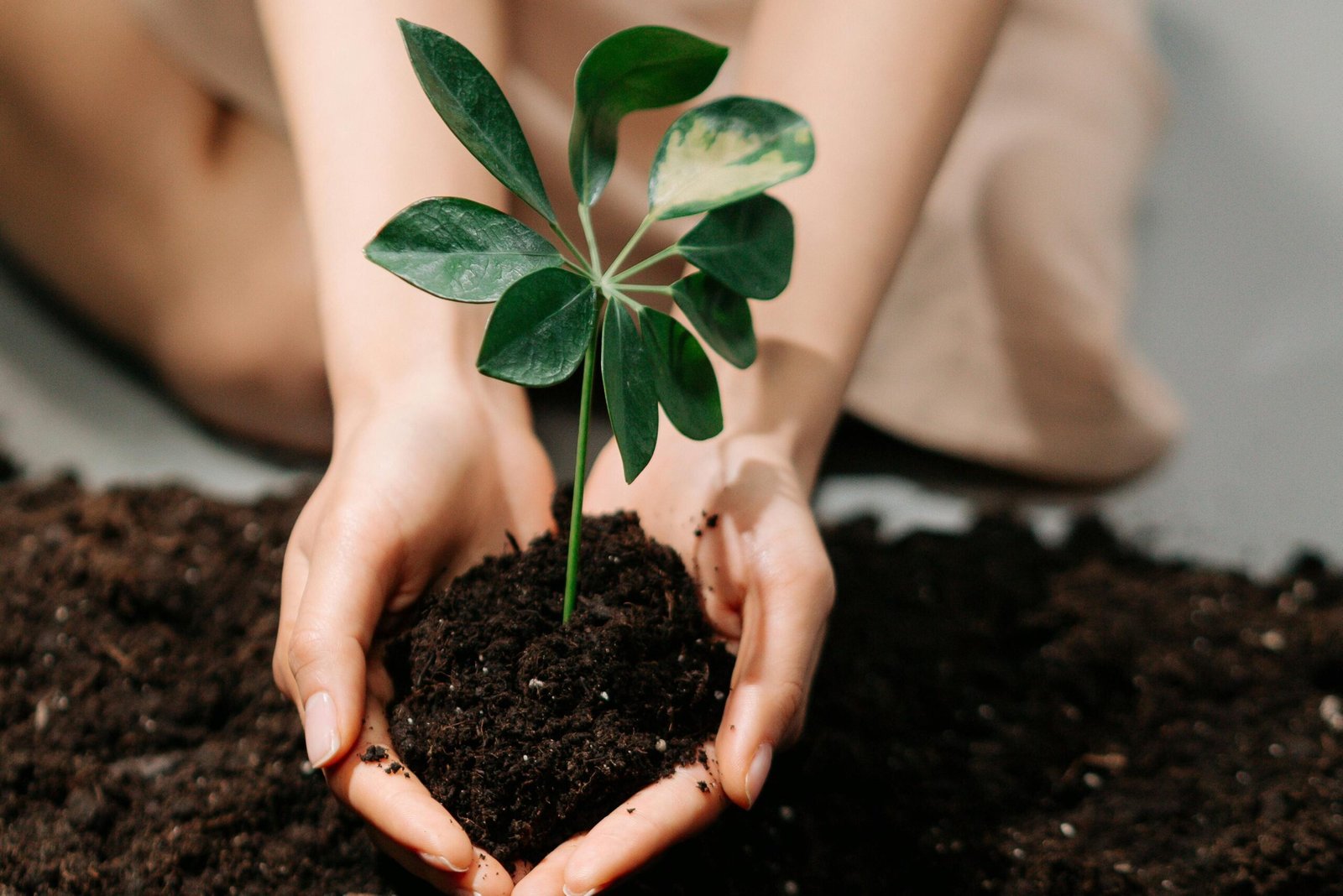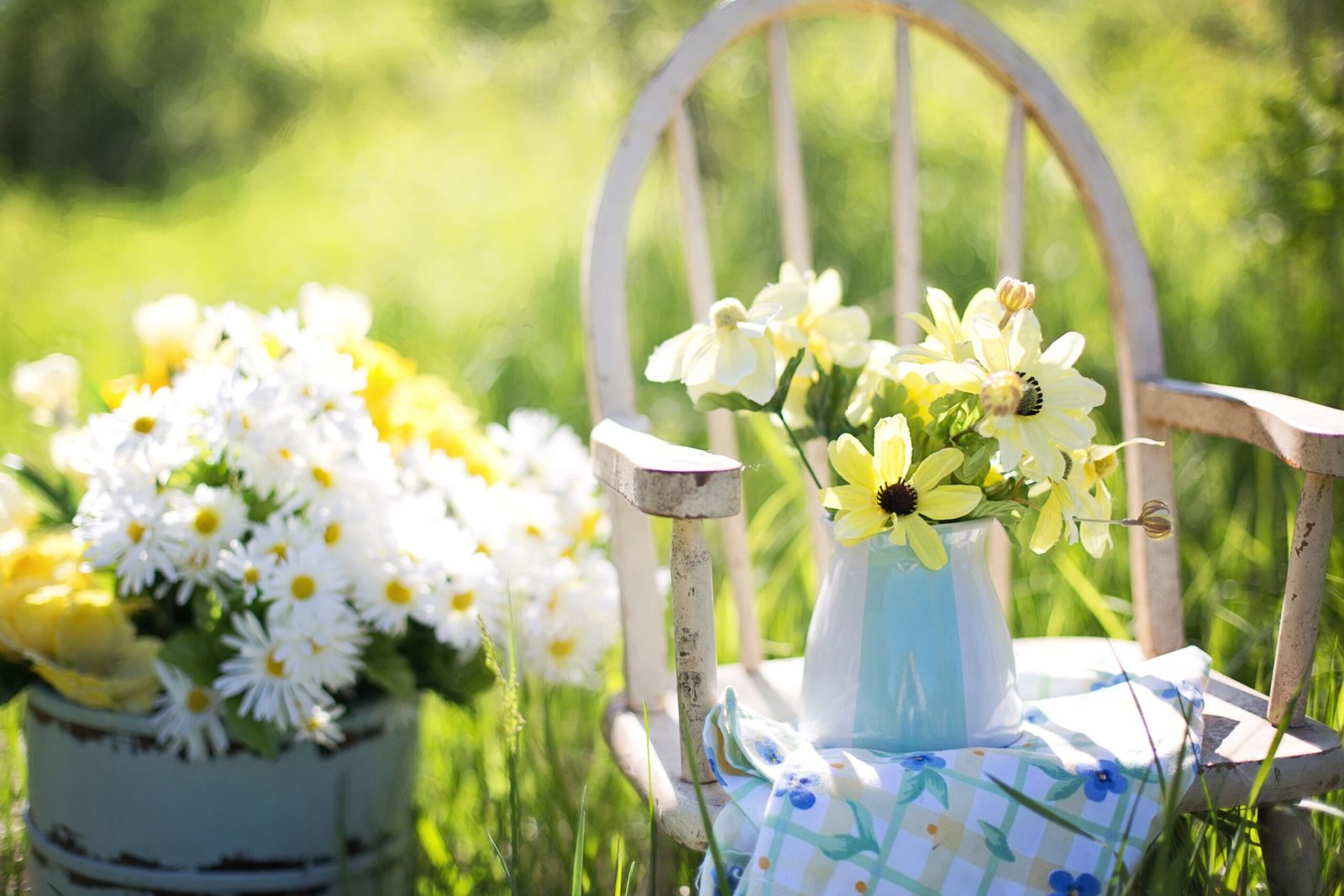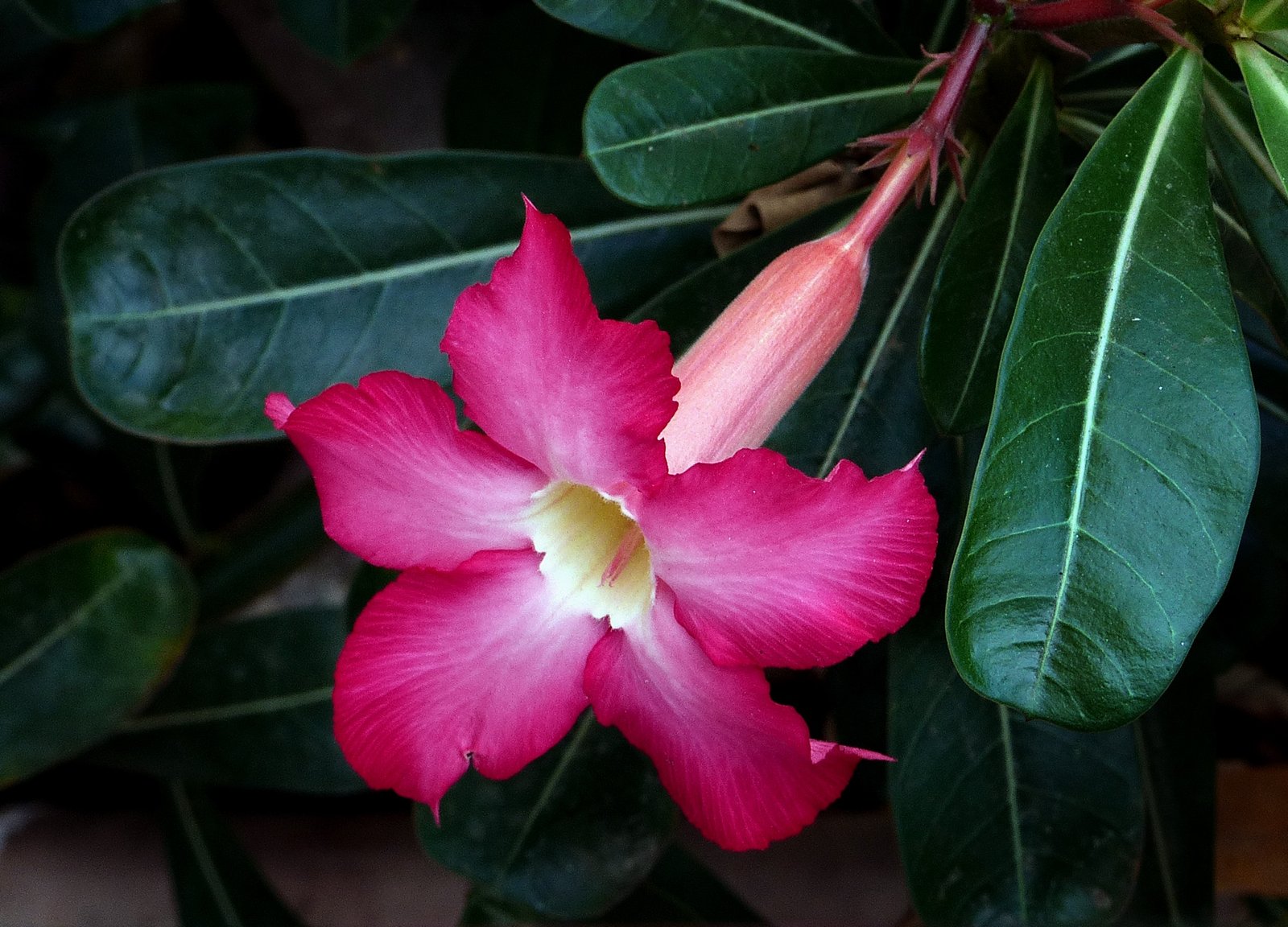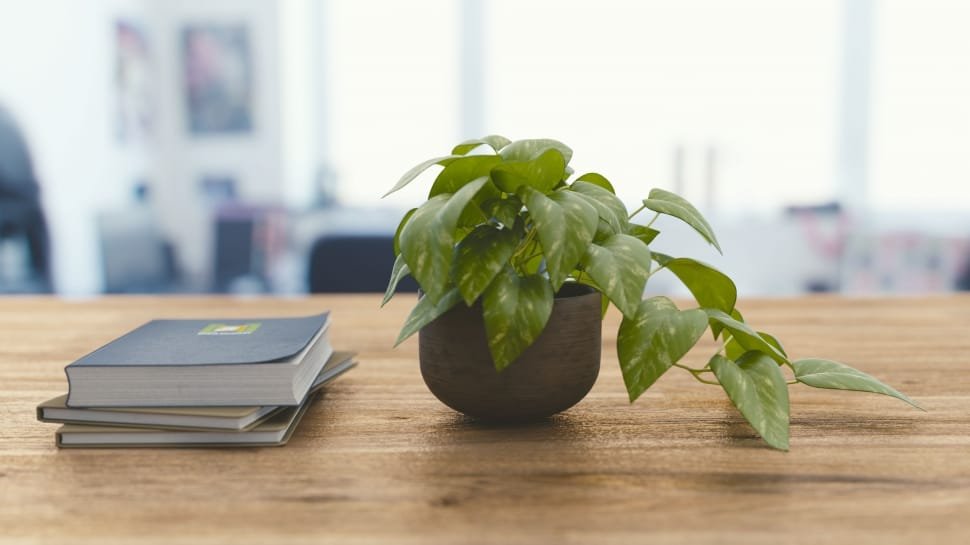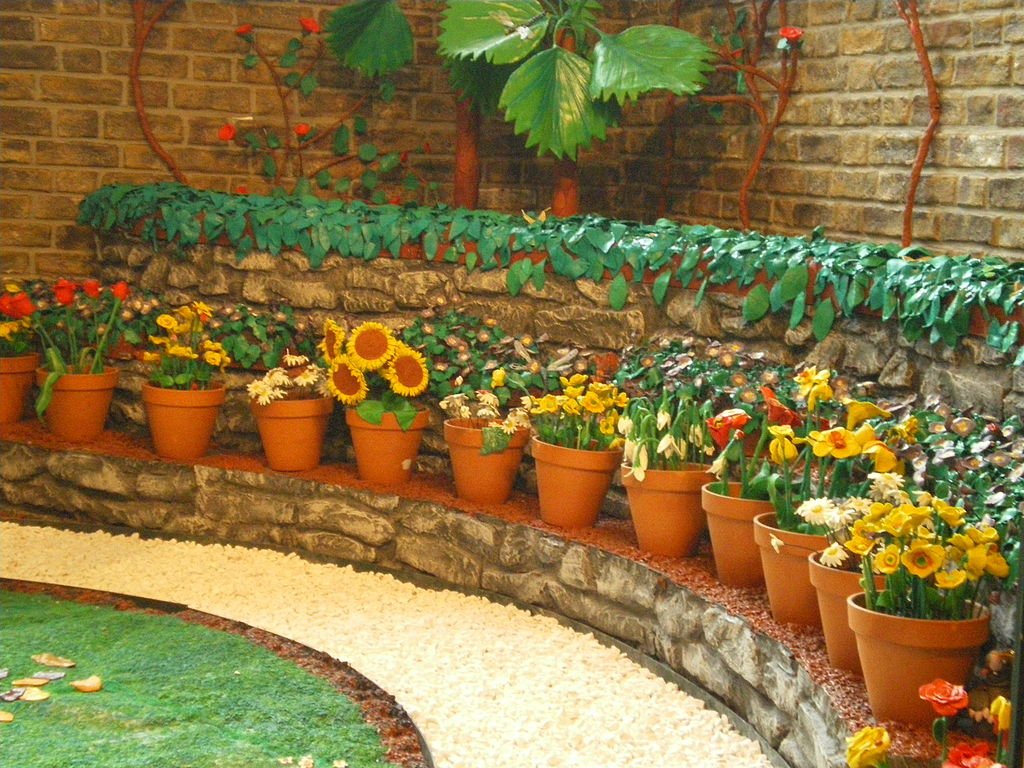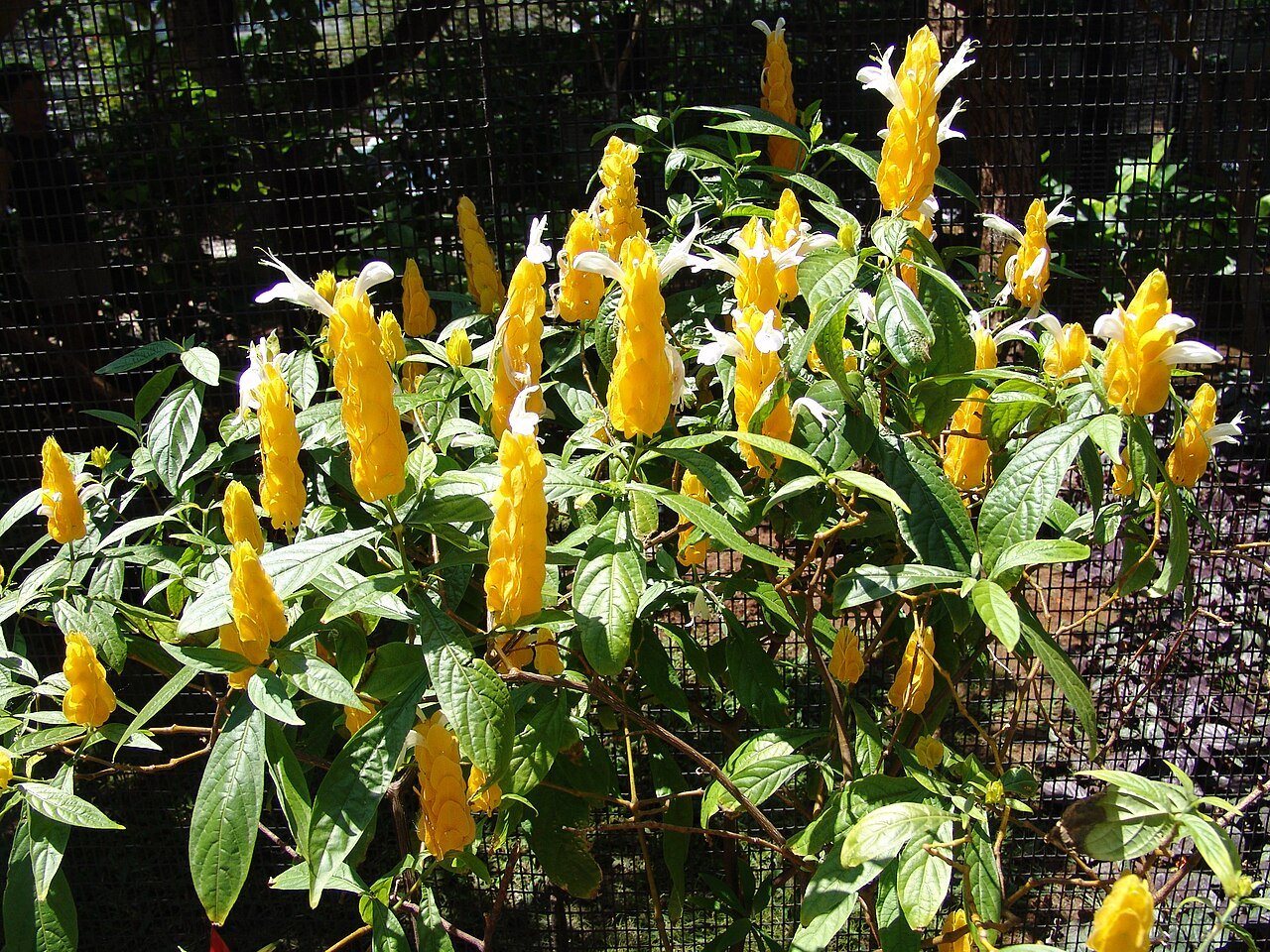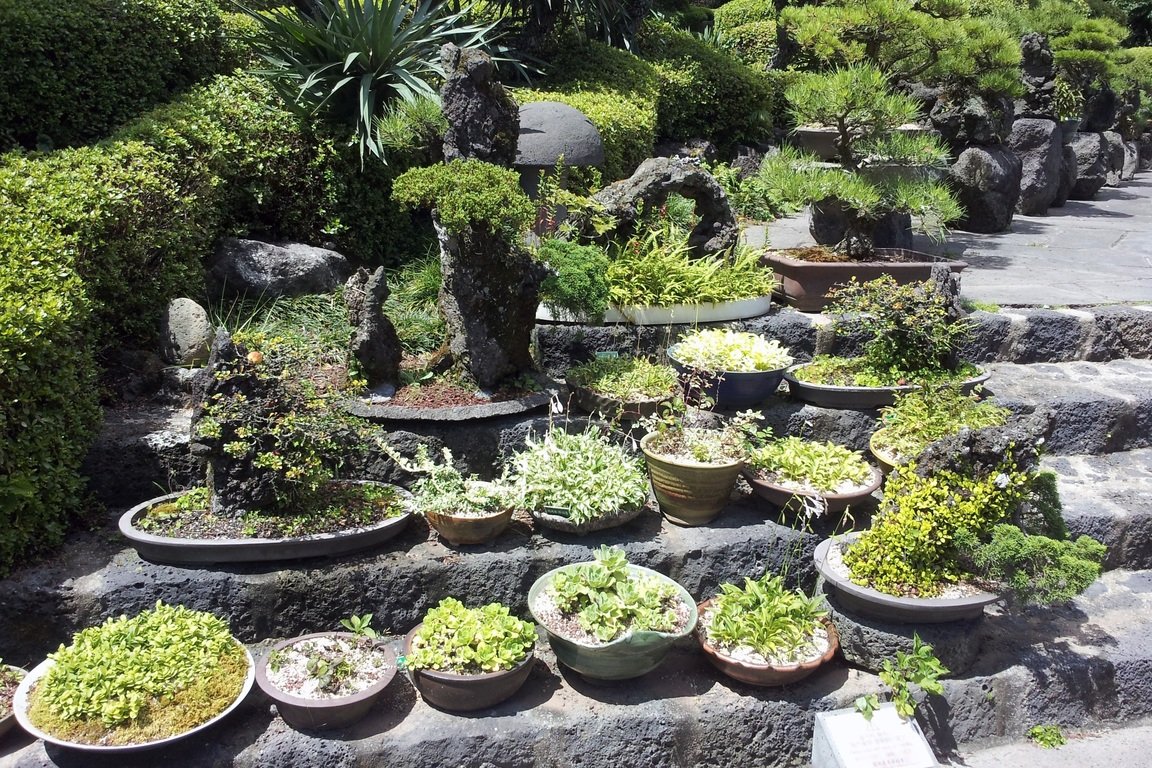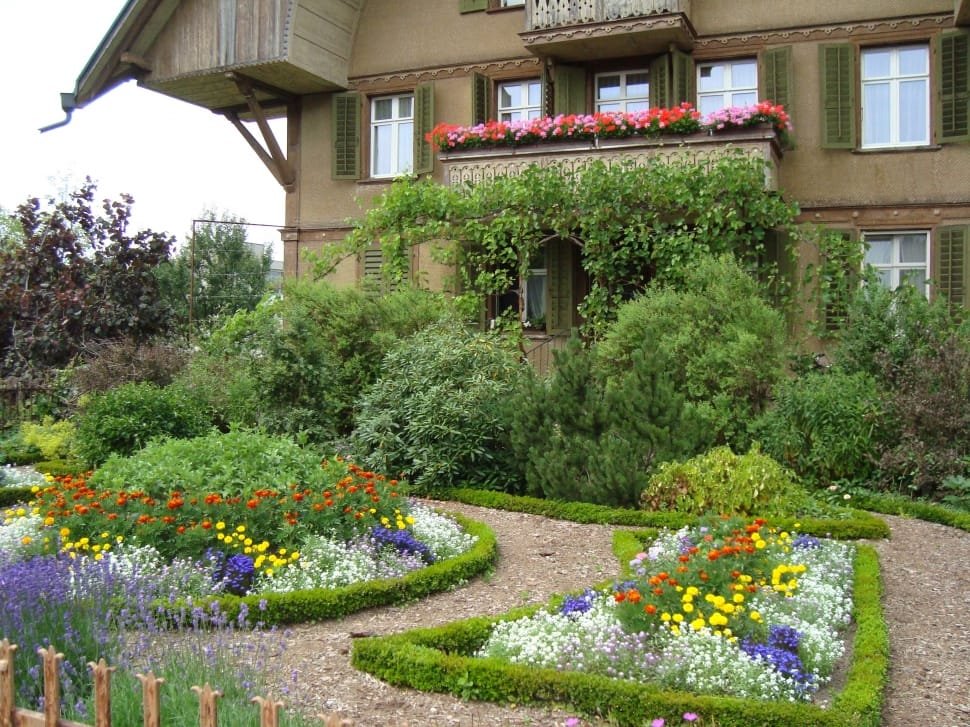We are going to explore the transformative power of green office solutions. In today’s fast-paced world, creating a green workspace has become more than just a trend; it’s a necessity. We understand the importance of office plants in fostering a productive and healthy environment. In this article, we’ll unveil the top 10 desk plants that will not only breathe life into your office but also elevate your green workspace to new heights. Whether you’re a seasoned plant enthusiast or just starting to explore the world of office plants, our comprehensive guide to desk plants will help you make your workspace thrive. Let’s dive in and discover the perfect green companions for your office desk!
Table of Contents
Which is the luckiest indoor plant?
When it comes to selecting the most auspicious indoor plant to enhance positive energy and good fortune in your home or office, look no further than the Lucky Bamboo (Dracaena sanderiana). This remarkable plant has been cherished in Asian cultures for over 5000 years as a powerful symbol of prosperity and luck.
The Lucky Bamboo plant, with its elegant, slender stalks and vibrant green leaves, is not only a beautiful addition to any indoor space but also holds deep-rooted cultural significance. Its association with luck and good fortune makes it a top choice for those seeking to optimize their living or working environments for success and positivity.
Incorporating a Lucky Bamboo plant into your decor not only adds a touch of natural elegance but also invites positive chi (energy) into your surroundings, according to the principles of Feng Shui. The plant’s unique ability to thrive in low light and minimal care requirements make it a hassle-free addition to any indoor setting.
To maximize the benefits of the Lucky Bamboo, consider placing it in a location that corresponds with your specific goals. For example, positioning it in the wealth area (southeast) of your home is believed to attract financial prosperity, while placing it in the career area (north) can boost career prospects.
When caring for your Lucky Bamboo, keep these tips in mind:
Water
Use distilled or purified water to prevent the buildup of minerals in the soil. Keep the water level just above the roots, ensuring they are submerged at all times.
Light
While Lucky Bamboo can thrive in low light conditions, it will appreciate some indirect sunlight. Avoid exposing it to direct sunlight, as this can scorch the leaves.
Container
Plant your Lucky Bamboo in a container with pebbles or stones to stabilize it and hold it upright. You can add decorative elements like figurines or crystals to enhance its positive energy.
Pruning
Trim yellowing or dead leaves to maintain the plant’s vitality and aesthetics.
What should I keep on my office desk as per Vastu?
According to Vastu Shastra, the ancient Indian system of architecture and design principles, arranging your office desk in a harmonious and balanced manner can have a positive impact on your work environment and overall productivity. Here are some items you can consider keeping on your office desk as per Vastu guidelines:
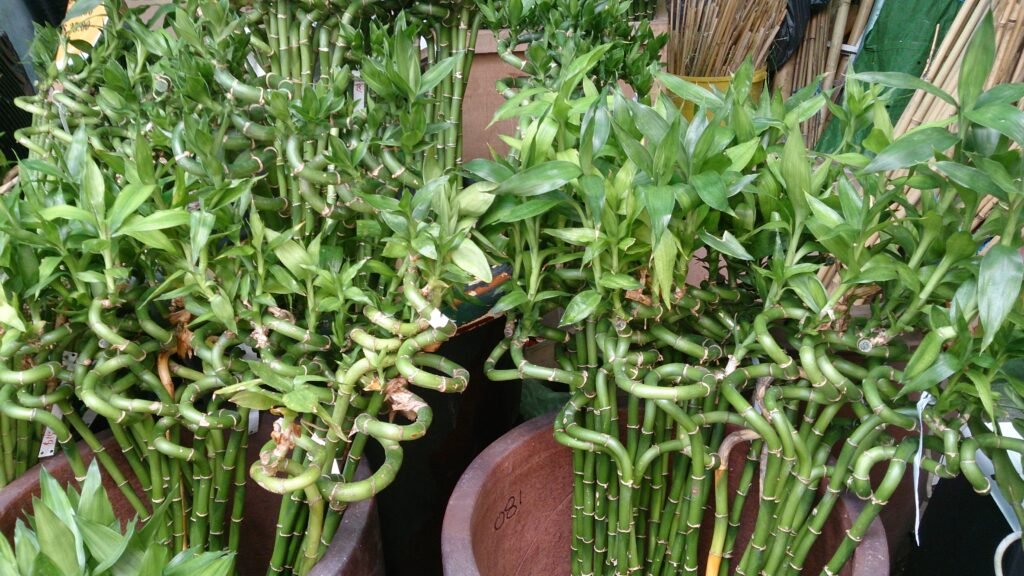
Bamboo Plant (Lucky Bamboo)
As mentioned, a bamboo plant is often recommended to remove negativity and attract positive energy. It is believed to bring good luck and prosperity. Make sure to place it in a well-lit area but away from direct sunlight.
Globe or World Map
A globe or world map symbolizes growth, expansion, and networking. It can help enhance your career prospects and business connections. Place it in the north or northeast direction of your desk for optimal results.
Table Clock
A table clock is essential for time management. Ensure that it is in good working condition and kept in the west or southwest direction on your desk. It represents discipline and helps you stay organized.
Notepad and Pen
Having a notepad and pen on your desk promotes organization and helps you jot down important thoughts, tasks, or reminders. Keep them neatly arranged to enhance your focus and efficiency.
Pyramid
A small pyramid made of crystal or other suitable materials can be placed on your desk to attract positive energy and balance the energies in your workspace. The pyramid’s pointed shape is believed to channel energy upward.
20 Plants to keep on your office desk according to plant experts
Aloe Succulent Plant
The Aloe succulent plant is not just a beautiful addition to your indoor space but also a natural healer and a source of tranquility. This remarkable plant is renowned for its soothing qualities, making it a perfect companion during those hectic, deadline-filled afternoons. Its versatility extends beyond the workspace, as it’s also a go-to remedy for mending that post-vacation sunburn.
Here’s why the Aloe succulent plant is an excellent choice:
Soothing Properties
Aloe vera gel, found in the leaves of the plant, is known for its cooling and healing properties. When you have a minor burn or irritated skin, breaking off a piece of the Aloe leaf and applying the gel can provide instant relief.
Air Purifier
Like other succulents, Aloe helps purify the air by removing toxins and improving indoor air quality. Breathing clean air can boost your overall well-being and productivity.
Low Maintenance
Aloe is a hardy plant that requires minimal care. It thrives in bright, indirect light and only needs occasional watering, making it an ideal choice for busy individuals.
Aesthetic Appeal
Aloe’s striking, spiky leaves and sleek appearance can enhance the visual appeal of your workspace. Its vibrant green color adds a touch of nature to your indoor environment.
Positive Vibes
In addition to its physical benefits, Aloe is often associated with positive energy. Its presence can create a sense of calm and tranquility in your surroundings, which can be especially beneficial during stressful workdays.
Ionantha Mexican Air Plants
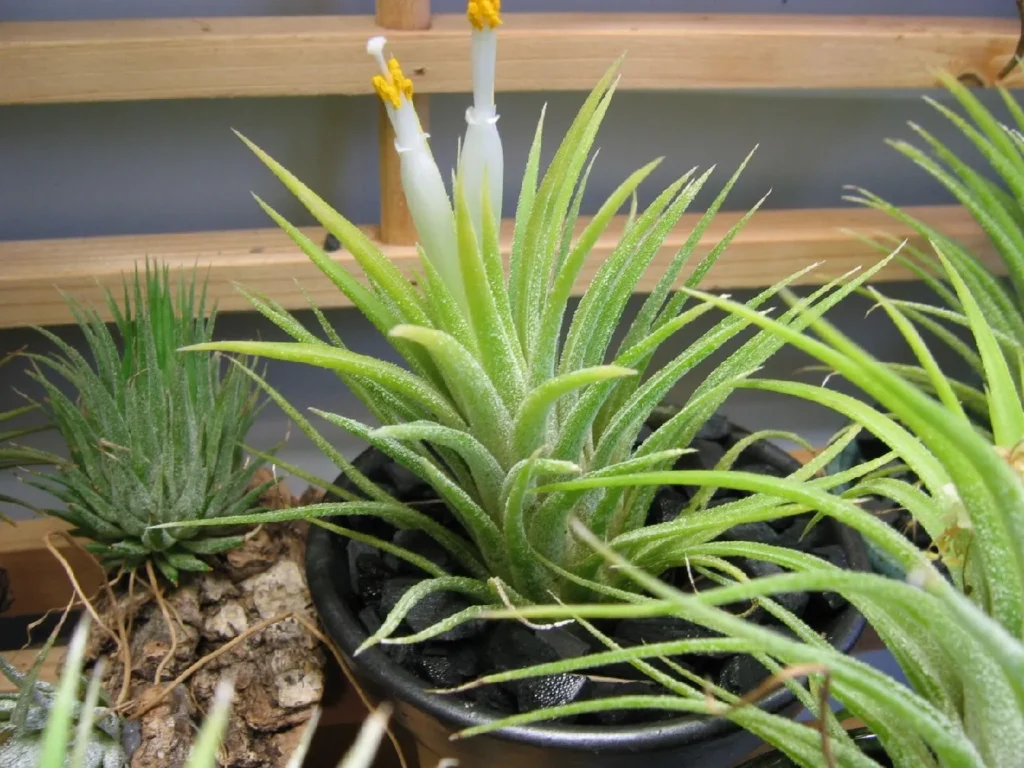
Ionantha Mexican Air Plants, also known as Tillandsia ionantha, are renowned for their unique beauty and incredibly simple maintenance. These low-maintenance plants are a popular choice for indoor plant enthusiasts due to their minimal care requirements.
Here’s why Ionantha Mexican Air Plants are a fantastic addition to your home or office:
Easy Maintenance
These air plants are a breeze to care for. As mentioned, all you need to do is soak them in water for approximately 20 minutes once a week. This hydrates the plants and provides them with the moisture they need to thrive. After their soak, allow them to fully dry before returning them to their display location.
No Soil Required
One of the most intriguing aspects of air plants is that they don’t require soil to grow. They obtain nutrients and moisture through their trichomes, which are tiny hair-like structures on their leaves. This makes them adaptable to various display options, from hanging containers to decorative arrangements.
Versatile Display
Due to their small size and lack of soil, Ionantha Mexican Air Plants can be displayed in creative and artistic ways. You can place them in glass terrariums, mount them on driftwood or stones, or simply set them in decorative containers. Their versatility allows you to showcase them in unique and visually appealing arrangements.
Unique Appearance
These air plants feature a captivating appearance with their compact rosette of leaves. They often turn a vibrant red or pink color when they are about to bloom, adding a touch of natural beauty to your indoor space.
Air Purification
While they may not be as effective as larger houseplants at purifying the air, air plants do contribute to indoor air quality by absorbing some airborne pollutants.
Costa Farms Devil’s Ivy Golden Pothos Plant
The Costa Farms Devil’s Ivy, also known as Golden Pothos or Devil’s Ivy, is a remarkable and resilient plant that thrives in a wide range of conditions. Whether you have a dimly lit corner or a sun-soaked office, this plant can adapt effortlessly to its surroundings. Here’s why it’s such a popular choice among indoor plant enthusiasts:
Versatile Lighting
Devil’s Ivy is known for its adaptability when it comes to lighting conditions. It can tolerate low-light environments, making it an ideal choice for offices or rooms with limited natural light. However, it can also do well in bright, indirect sunlight. This versatility allows you to place it virtually anywhere in your home or office.
Low Maintenance
This plant is a favorite for those seeking a low-maintenance green companion. It’s forgiving when it comes to watering. While it prefers slightly moist soil, it can endure occasional periods of drought. Keeping an eye on its leaves is a great way to determine its watering needs. Yellowing leaves may indicate overwatering, while a droopy appearance suggests it’s time for a drink.
Air Purification
Devil’s Ivy is an excellent air purifier, helping to remove common indoor pollutants. Its presence can contribute to better indoor air quality, making your workspace a healthier environment.
Aesthetic Appeal
With its heart-shaped leaves that feature stunning variegation, Devil’s Ivy is not just easy to care for but also visually appealing. It can be displayed in hanging baskets or placed on shelves, allowing its trailing vines to create an elegant, cascading effect.
Positive Energy
In addition to its aesthetic charm, Devil’s Ivy is often associated with positive energy and Feng Shui principles. Its vibrant green leaves are believed to attract prosperity and good fortune.
While ZZs thrive in moderate to brighter light environments, they’ll still hold up just fine in low light. The plants also require little water, like a cactus, so you don’t have to worry about watering them all the time. If the leaves start falling off, replenish it with water and it’ll bounce right back.
To care for your Costa Farms Devil’s Ivy, maintain a consistent watering schedule, allowing the top inch or so of the soil to dry out between waterings. Pruning the plant can encourage fuller growth and help manage its shape.
With its adaptability and ease of care, Devil’s Ivy is an excellent choice for both beginners and experienced plant enthusiasts, adding beauty and a touch of nature to any space, even in the busiest of offices.
Spider Plant
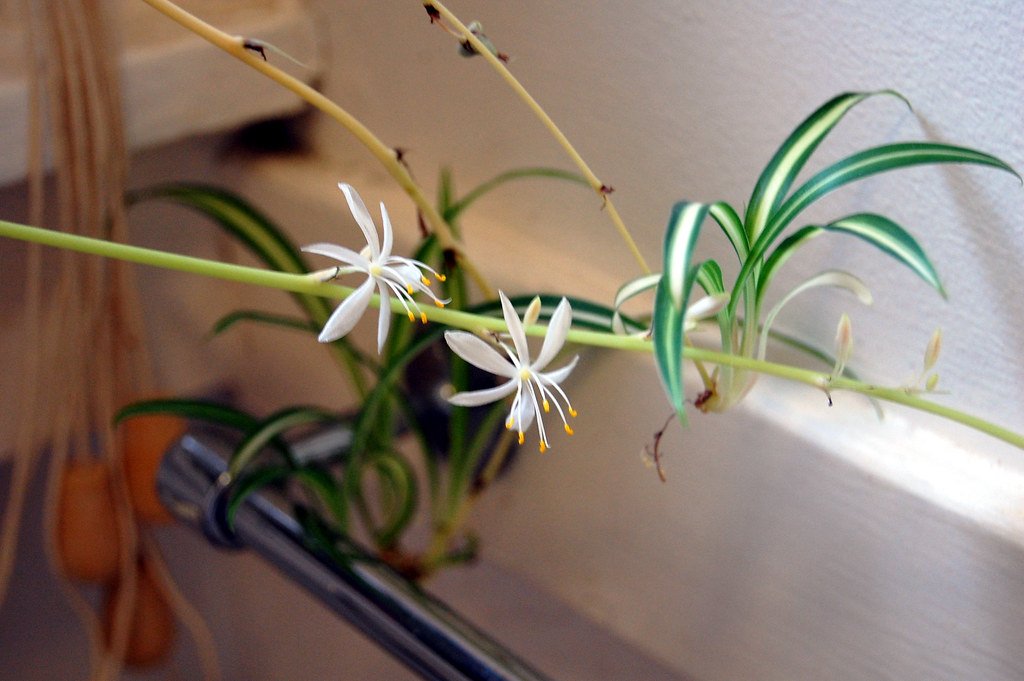
The Spider Plant (Chlorophytum comosum) is a popular and hardy houseplant known for its unique appearance and air-purifying qualities. If you’re considering adding one to your indoor space, here are some care tips to ensure it thrives:
Watering
Spider plants are relatively low-maintenance when it comes to watering. They prefer to dry out slightly between waterings, so it’s best to water them when the top inch of soil feels dry to the touch. Typically, this means you can go a few days between waterings, making them forgiving if you occasionally forget to water. Overwatering can lead to root rot, so it’s essential not to keep the soil consistently soggy.
Lighting
Spider plants thrive in bright, indirect sunlight. While they can tolerate lower light conditions, they’ll do best in a spot where they receive filtered or indirect sunlight. They can also adapt to artificial lighting, making them suitable for offices or areas with limited natural light.
Temperature
Spider plants prefer temperatures between 60°F to 75°F (15°C to 24°C). They can tolerate slightly cooler temperatures but should be protected from frost.
Potting Soil
Use well-draining potting soil that allows excess water to escape. A mix designed for houseplants or a blend of peat-based soil with perlite or vermiculite works well.
Fertilizing
During the growing season (spring and summer), you can feed your spider plant with a balanced, water-soluble fertilizer every 2-4 weeks. Reduce or stop fertilizing during the fall and winter when the plant’s growth slows down.
Pruning
Spider plants produce long, arching leaves that can sometimes become leggy. Pruning can help maintain a more compact and attractive appearance. You can trim brown or yellowing leaves and remove any offsets (baby spider plants) to propagate or replant them.
Propagation
Spider plants are easy to propagate. They produce offsets or “pups” that can be carefully separated from the parent plant and planted in their pots.
Spider plants are not only visually appealing but also known for their air-purifying abilities, helping to remove common indoor pollutants. With their forgiving nature and adaptability to various light conditions, they make an excellent addition to both home and office environments. Just remember to avoid overwatering and provide them with the right amount of light to keep them healthy and vibrant.
Snake Plants for office
Snake Plants, also known as Sansevieria or Mother-in-Law’s Tongue, are indeed renowned for their remarkable resilience and adaptability. These hardy houseplants are a top choice for individuals with busy schedules or those who may not have a green thumb. Here’s why Snake Plants are a favorite among low-maintenance plant enthusiasts:
Low Light Tolerance
Snake Plants thrive in low to moderate light conditions, making them perfect for spaces with limited natural sunlight. They can tolerate dim corners, making them ideal for offices, bedrooms, or other areas with low light levels.
Minimal Water Requirements
These plants are incredibly forgiving when it comes to watering. They prefer to dry out completely between waterings, which means you can water them sparingly. Overwatering is a more significant threat to Snake Plants than underwatering, so it’s better to err on the side of caution.
Air Purification
Snake Plants are well-known for their air-purifying qualities. They can help remove toxins from the air, making your indoor environment healthier and more enjoyable to be in.
Aesthetic Appeal
With their striking vertical leaves that can vary in color and pattern, Snake Plants are visually appealing. They can complement a wide range of interior design styles and add a touch of nature to your space.
Ease of Maintenance
Snake Plants require minimal attention. You don’t need to worry about frequent repotting or complex care routines. They are also relatively pest-resistant.
Propagation
Snake Plants can be easily propagated by dividing their rootball or by leaf cuttings, making them a sustainable and budget-friendly choice.
Positive Reviews
As you mentioned, Snake Plants have a reputation for being nearly indestructible, earning them nicknames like “indestructible houseplant.” This reputation is well-deserved, as they can survive neglect and adverse conditions.
Succulents Plants A succulent can actually store water in its thick leaves. Therefore, the plant couldn’t be easier to take care of and doesn’t require constant watering. It’s great if you just want to have something nice to see at your desk!
Snake Plants are the ultimate choice for individuals who lead busy lives or are new to plant care. Their ability to thrive in low light and tolerate infrequent watering makes them an excellent option for practically any indoor setting. Whether you’re a seasoned plant enthusiast or a beginner, these resilient plants can enhance your living or working space effortlessly, and their “impossible to kill” reputation makes them a favorite among many.
Bamboo
Bamboo, often referred to as “lucky bamboo,” is a beloved plant in various cultures due to its association with positive energy and good fortune. It’s a fantastic choice for office cubicles and workspaces, and it can indeed bring a Feng Shui boost to your environment. Here’s why bamboo is well-suited for office settings:
Low Light Tolerance
Bamboo is well-known for its ability to thrive in low light conditions. It can flourish with minimal exposure to natural sunlight, making it an ideal choice for indoor spaces with limited access to windows or direct sunlight, such as cubicles.
Feng Shui Enhancement
In Feng Shui, bamboo is often used to attract positive chi (energy) and promote harmony and balance. Its upward growth is believed to symbolize progress and growth in one’s career, which aligns perfectly with office settings.
Minimal Care Requirements
Bamboo is a low-maintenance plant that requires little attention. It needs only a small amount of water and can thrive in water-filled containers without the need for soil. Ensure that the water level remains consistent and change the water every few weeks to prevent stagnation.
Space Efficiency
Bamboo is typically grown in slender, elegant stalks, making it a space-efficient choice for cubicles and smaller workspaces. It can be placed on a windowsill or desktop, adding a touch of nature without taking up much room.
Positive Vibes
Beyond its aesthetic appeal, bamboo’s presence can create a sense of calm and positivity in your workspace, which can be particularly beneficial during busy workdays.
Decorative Options
Bamboo can be displayed in various ways, from traditional pots to decorative containers filled with water or stones. These options allow you to customize your bamboo’s presentation to suit your personal style and office decor.
Bamboo is a versatile and “lucky” plant that can thrive in low light conditions, making it an excellent choice for office cubicles and workspaces. Its Feng Shui symbolism, minimal care requirements, and positive energy are just a few reasons why it’s a popular addition to office environments. By incorporating bamboo into your workspace, you can not only enhance the aesthetics but also invite positivity and good fortune into your professional life.
Peace Lily
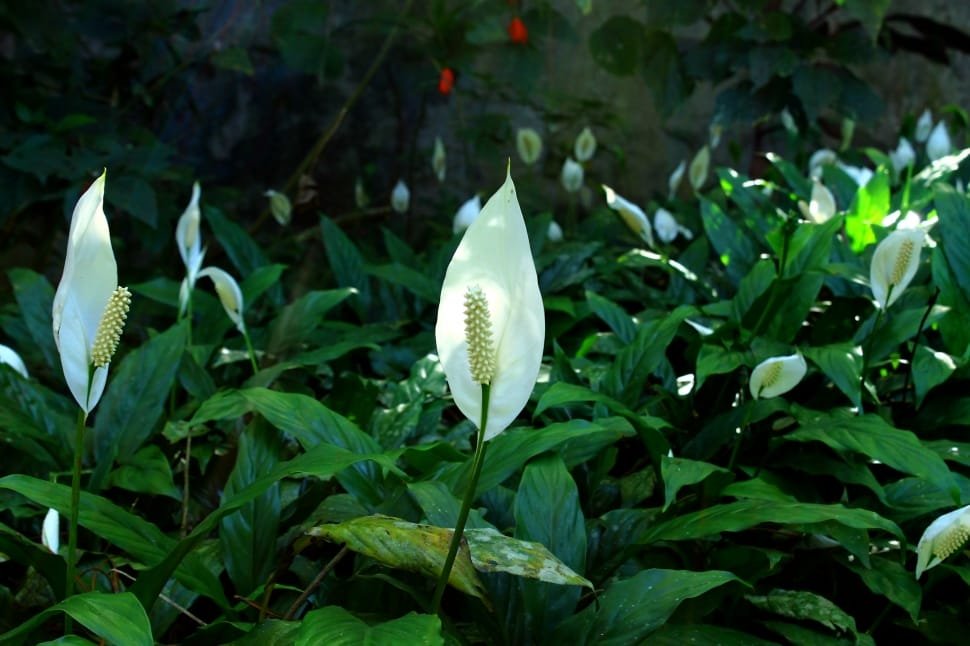
Peace Lilies (Spathiphyllum) are indeed beautiful and relatively easy to care for indoor plants. They are known for their elegant white spathes and lush foliage, making them a popular choice for homes and offices. Here are some key care tips for Peace Lilies:
Moist Soil
Peace Lilies thrive when the soil is kept consistently moist. Water them thoroughly when the top inch or so of soil feels dry to the touch. However, be cautious not to overwater, as they are sensitive to waterlogged conditions, which can lead to root rot.
Misting
Peace Lilies appreciate high humidity levels. Misting the leaves regularly can help create a more humid microenvironment around the plant. This is especially beneficial if you live in a dry climate or during the winter months when indoor air tends to be drier.
Indirect Light
While Peace Lilies do need some light to thrive, they prefer bright, indirect sunlight. Avoid placing them in direct sunlight, as it can scorch their leaves. They are well-suited for areas with filtered or low light conditions, making them versatile for various indoor spaces.
Pruning
As Peace Lilies grow, you may want to prune them occasionally to maintain their shape and appearance. Remove any yellowing or damaged leaves and spent flowers to encourage new growth.
Repotting
These plants don’t require frequent repotting. Repot when you notice that the plant has become root-bound or when it has outgrown its current container. Generally, every couple of years is sufficient.
Fertilizing
Peace Lilies do not need heavy feeding. You can fertilize them with a balanced, water-soluble fertilizer diluted to half strength every 2-4 weeks during the growing season (spring and summer). Reduce or stop fertilizing during the fall and winter when their growth slows down.
Toxicity
Keep in mind that Peace Lilies are toxic if ingested, so it’s essential to keep them out of reach of pets and children.
Peace Lilies are not just attractive but are also known for their air-purifying qualities. They can help remove common indoor pollutants, contributing to better indoor air quality. With proper care and attention to their specific needs, you can enjoy the beauty of Peace Lilies in your indoor space for years to come.
Red Aglaonema
The Red Aglaonema, with its vibrant pink stems and striking reddish-pink leaf tips, is a visually captivating and popular choice for adding a touch of personality and color to your desk or indoor space. Here are some key details and care tips for this stunning plant:
Colorful Appearance
The Red Aglaonema’s bold and vibrant colors make it a standout addition to any workspace or home. Its unique foliage adds a splash of pink and red that’s sure to catch the eye.
Light Requirements
While the Red Aglaonema displays its most vivid colors when placed in bright, indirect light, it is also well-suited for low-light conditions. This adaptability makes it an excellent choice for office environments with limited natural light.
Watering
Like many other Aglaonema varieties, the Red Aglaonema prefers to dry out slightly between waterings. It’s essential to avoid overwatering, as excessive moisture can lead to root rot. Water the plant when the top inch of soil feels dry to the touch, and allow any excess water to drain from the pot.
Temperature and Humidity
Red Aglaonemas thrive in typical indoor temperatures, but they appreciate higher humidity levels. You can increase humidity by misting the plant regularly or placing it on a tray filled with water and pebbles. Maintaining a comfortable room temperature is generally suitable for this plant.
Maintenance
Pruning the Red Aglaonema can help maintain its shape and appearance. Remove any yellowing or dead leaves to encourage new growth and keep the plant looking vibrant.
Fertilizing
During the growing season (spring and summer), you can feed your Red Aglaonema with a balanced, water-soluble fertilizer diluted to half strength every 4-6 weeks. Reduce or stop fertilizing during the fall and winter when the plant’s growth slows down.
Toxicity
Keep in mind that Red Aglaonemas are toxic if ingested, so it’s essential to keep them out of reach of pets and children.
Overall, the Red Aglaonema is a captivating and relatively low-maintenance plant that can thrive in various lighting conditions. Whether you place it in a brightly lit area to showcase its vivid colors or in a low-light spot, its unique and colorful foliage will surely brighten up your workspace and add a touch of personality to your desk.
Begonia Maculata
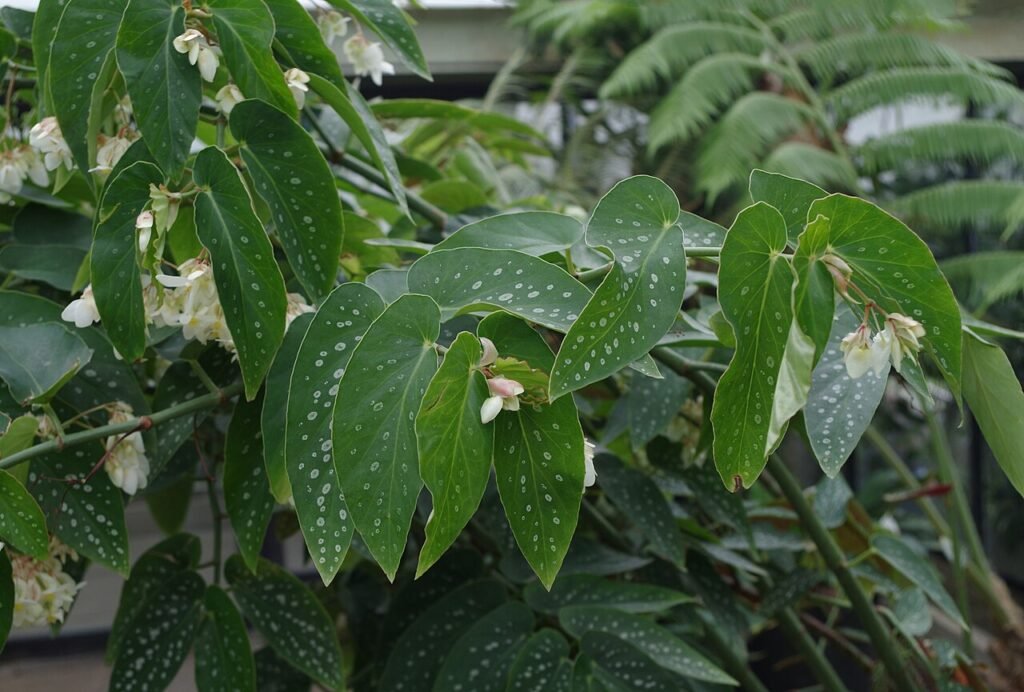
The Begonia Maculata, often referred to as the Polka Dot Begonia due to its unique and striking appearance, is a captivating and somewhat whimsical plant that adds a touch of artistic flair to any indoor space. Here are some care tips to help you keep your Begonia Maculata healthy and thriving:
Light Requirements
The Begonia Maculata’s signature polka-dotted leaves display their boldest coloration when exposed to bright, indirect light. While it can tolerate lower light conditions, providing it with ample light will enhance its vibrant appearance. However, avoid direct sunlight, as it can scorch the leaves.
Watering
Begonia Maculatas appreciate consistently moist soil, but they don’t like to be waterlogged. Allow the top inch or so of the soil to dry out between waterings. When you do water, ensure that the pot has drainage holes to allow excess water to escape. Overwatering can lead to root rot, so it’s crucial not to let the plant sit in standing water.
Humidity
This plant prefers higher humidity levels. In indoor environments with dry air, especially during the winter months, misting the leaves regularly can help increase humidity around the plant. Alternatively, you can place a tray filled with water and pebbles near the Begonia to create a more humid microenvironment.
Temperature
Begonia Maculatas thrive in temperatures between 60°F to 75°F (15°C to 24°C). Avoid exposing them to drafts or sudden temperature fluctuations.
Pruning
Prune your Begonia Maculata to encourage bushier growth and to maintain its desired shape. Regularly remove any dead or yellowing leaves.
Fertilizing
During the growing season (spring and summer), you can feed your Begonia Maculata with a balanced, water-soluble fertilizer diluted to half strength every 4-6 weeks. Reduce or stop fertilizing during the fall and winter when the plant’s growth slows down.
Potting Mix
Use a well-draining potting mix that allows excess water to escape. A mix formulated for houseplants or one that includes perlite or vermiculite works well.
The Begonia Maculata’s artistic and somewhat Tim Burton-esque appearance can make it a conversation piece and a unique addition to your indoor plant collection. With proper care, it will reward you with its distinctive beauty and character. Just remember to balance its light, humidity, and watering needs to keep it flourishing.
English Ivy
English Ivy (Hedera helix) is a classic and versatile plant known for its lush green foliage and trailing vines. It’s a popular choice for both indoor and outdoor settings due to its adaptability and aesthetic appeal. Here are some key care tips for English Ivy:
Initial Watering
When you first plant or transplant English Ivy, it’s essential to keep the soil consistently moist to help it establish its roots. Regular watering during the early stages of growth will encourage healthy development.
Established Plants
Once English Ivy is well-established, it becomes more drought-tolerant and can withstand periods of dry soil. Allow the top inch or so of the soil to dry out between waterings. Water the plant thoroughly when needed, but avoid overwatering, as this can lead to root rot.
Light Requirements
English Ivy prefers bright, indirect sunlight but can tolerate lower light conditions. It’s an excellent choice for offices with less natural light, as it can adapt to varying light levels. However, it may not grow as vigorously in low-light environments.
Temperature
English Ivy does well in cooler temperatures, making it suitable for offices or rooms known for being chilly. It thrives at room temperature but can tolerate slightly cooler conditions.
Pruning and Maintenance
Pruning your English Ivy can help maintain its shape and prevent it from becoming too leggy. Regularly trim back long vines and remove any yellowing or dead leaves. This promotes bushier growth and keeps the plant looking tidy.
Humidity
While English Ivy can tolerate average indoor humidity levels, it appreciates higher humidity. Misting the plant occasionally or using a humidifier can be beneficial, especially during the dry winter months.
Fertilizing
Fertilize your English Ivy sparingly, typically during the growing season (spring and summer). Use a balanced, water-soluble fertilizer diluted to half strength every 4-6 weeks.
Pest Management
Keep an eye out for common indoor plant pests like spider mites and mealybugs, which can occasionally affect English Ivy. Regularly inspect the plant’s leaves and treat any infestations promptly.
Support
Provide support for your English Ivy if you want it to climb or trail. You can use trellises, stakes, or let it cascade from hanging containers.
English Ivy is not only an attractive addition to your indoor space but also known for its air-purifying qualities. With its adaptability to various light levels and its ability to thrive in cooler environments, it’s a versatile and appealing choice for office settings, adding a touch of natural beauty to your workspace.
Sansevieria
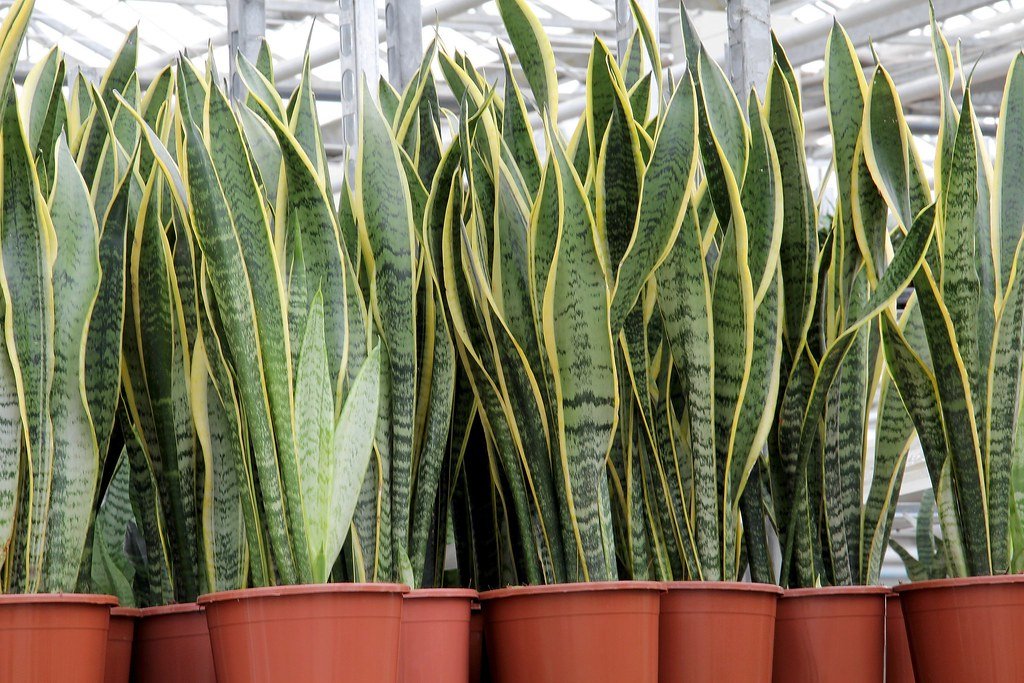
Sansevieria, often known as the Snake Plant or Mother-in-Law’s Tongue, is a popular and resilient houseplant. However, it’s worth noting that the description you provided, mentioning the Whale Fin succulent, appears to be about a different plant species. Let’s briefly discuss both:
Whale Fin Succulent (Sansevieria Masoniana):
- This succulent is indeed distinctive for its large, paddle-shaped leaves that resemble a whale’s fin, which is how it got its common name.
- Similar to other Sansevieria species, it can tolerate low and indirect light conditions, making it suitable for various indoor settings.
- Regularly dusting the leaves is a good practice for all houseplants, including Sansevieria, to prevent dust buildup and discourage pests.
Sansevieria (Snake Plant or Mother-in-Law’s Tongue):
- Sansevieria is known for its upright, sword-like leaves with varying patterns, depending on the variety.
- It is exceptionally resilient and can thrive in a wide range of light conditions, from low light to bright, indirect sunlight.
- Like the Whale Fin Succulent, regular dusting is advisable to maintain the health and appearance of its leaves.
Both of these plants are excellent choices for indoor spaces due to their adaptability and low maintenance requirements. If you are specifically looking for information about the Whale Fin Succulent or Sansevieria, please clarify, and I’d be happy to provide more detailed care instructions for the plant you’re interested in.
Baltic Blue Pothos
The Baltic Blue Pothos, also known as Epipremnum aureum ‘Baltic Blue,’ is a unique and captivating variety of the popular Pothos plant. It is distinguished by its glossy leaves that develop natural holes as they mature, creating an intriguing and textured appearance. Here are some care tips and insights into this beautiful and distinctive plant:
Leaf Development
As the Baltic Blue Pothos leaves grow and mature, they naturally develop fenestrations or holes. This characteristic sets it apart from other Pothos varieties and adds to its aesthetic appeal. These holes are not due to pests or damage but are a normal part of the plant’s growth pattern.
Leaf Color
The name “Baltic Blue” is derived from the unique bluish-green or teal-like hue that the leaves can take on as they mature. This coloration is more pronounced in well-lit conditions, so providing it with bright, indirect sunlight can enhance its blueish tint.
Light Requirements
Baltic Blue Pothos can tolerate a range of light conditions, from low to bright, indirect light. However, to bring out its blue coloration and encourage healthy growth, it’s best to provide it with moderate to bright, indirect sunlight.
Watering
Like other Pothos varieties, it’s important not to overwater the Baltic Blue Pothos. Water it when the top inch of the soil feels dry to the touch, and allow excess water to drain from the pot. Ensure that the pot has proper drainage to prevent waterlogged soil, which can lead to root rot.
Temperature and Humidity
Maintain average room temperatures, ideally between 65°F to 80°F (18°C to 27°C). The Baltic Blue Pothos can adapt to standard indoor humidity levels, but it appreciates higher humidity. Misting the plant or using a humidifier can help provide the necessary moisture.
Fertilizing
During the growing season (spring and summer), you can feed your Baltic Blue Pothos with a balanced, water-soluble fertilizer diluted to half strength every 4-6 weeks. Reduce or stop fertilizing during the fall and winter when the plant’s growth slows down.
Maintenance
Pruning can help maintain the plant’s shape and encourage bushier growth. Trim back leggy or overgrown vines as needed. You can also propagate the cuttings to grow new plants.
The Baltic Blue Pothos is a captivating and unique addition to any indoor plant collection. Its glossy, hole-riddled leaves and potential teal-like coloration make it a standout plant that can add character and charm to your living or working space.
Prickly Pear Cactus
The Prickly Pear Cactus, known for its distinctive flattened pads resembling a beaver’s tail, is indeed one of the easiest succulents to care for. Here are some care tips for this low-maintenance and unique plant:
Watering
Prickly Pear Cacti have low water requirements. Water them sparingly, allowing the soil to dry out completely between waterings. During the growing season (spring and summer), you can water them more often, but in the dormant period (fall and winter), reduce watering to avoid overhydration.
Light Requirements
These cacti thrive in bright, direct sunlight. Place them in a location where they can receive several hours of sunlight each day, such as a sunny windowsill or a well-lit outdoor area.
Temperature
Prickly Pear Cacti are typically hardy and can tolerate a wide range of temperatures. They do best in temperatures between 70°F to 100°F (21°C to 37°C) during the growing season and can withstand cooler temperatures in the winter, down to around 50°F (10°C).
Pot and Soil
Use well-draining cactus or succulent soil mix for your Prickly Pear Cactus. A pot with drainage holes is essential to prevent waterlogged soil, which can be detrimental to the plant.
Fertilizing
Prickly Pear Cacti are not heavy feeders. You can fertilize them sparingly during the growing season with a diluted, balanced, water-soluble cactus or succulent fertilizer. Typically, fertilize every 4-6 weeks.
Spikes and Handling
Be cautious when handling Prickly Pear Cacti, as they have sharp spines that can cause irritation or injury. Wear gloves or use tongs when necessary. Additionally, place the cactus in a location where it won’t be accidentally bumped or touched to avoid contact with the spines.
Repotting
These cacti do not require frequent repotting. Repot when they have outgrown their current container or become root-bound. This is typically needed every few years.
Pruning
Prune your Prickly Pear Cactus as needed to maintain its shape and remove any damaged or dead pads.
The Prickly Pear Cactus is an attractive and low-maintenance succulent that can thrive with minimal care. Its unique appearance and ability to withstand infrequent watering and low-fertilization needs make it a great choice for larger desks or outdoor spaces. Just be mindful of its sharp spines and ensure it receives adequate sunlight to thrive.
Money Tree
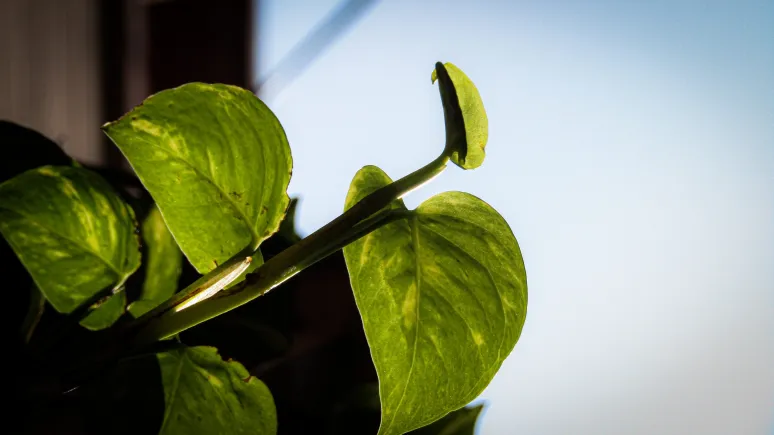
The Money Tree (Pachira aquatica) is a popular indoor plant often associated with prosperity and positive energy in various cultures. It’s an excellent choice for desk decoration, and it’s known for its ease of care. Here are some care tips for your Money Tree:
Light Requirements
While Money Trees can tolerate low light conditions, they do best in moderate to bright, indirect sunlight. Placing it near a window with filtered light is ideal. Avoid direct sunlight, as it can scorch the leaves.
Watering
Money Trees prefer to dry out slightly between waterings. Water the plant thoroughly when the top inch or so of the soil feels dry to the touch. Ensure that the pot has drainage holes to prevent water from pooling at the bottom, as overwatering can lead to root rot.
Humidity
Money Trees can adapt to average indoor humidity levels, but they appreciate slightly higher humidity. Misting the plant occasionally or placing it near a humidifier can help provide the necessary moisture.
Temperature
Maintain a comfortable room temperature for your Money Tree, ideally between 65°F to 80°F (18°C to 27°C). Protect it from drafts and sudden temperature fluctuations.
Fertilizing
You can feed your Money Tree with a balanced, water-soluble fertilizer diluted to half strength every 4-6 weeks during the growing season (spring and summer). Reduce or stop fertilizing during the fall and winter when its growth slows down.
Pruning
Pruning your Money Tree can help maintain its shape and encourage a bushier growth habit. Trim back any leggy or overgrown branches as needed.
Repotting
Money Trees don’t require frequent repotting. Repot when you notice that the plant has outgrown its current container or when you see signs of root congestion. Typically, repotting every couple of years is sufficient.
Braiding
Some Money Trees are grown with braided trunks, which is purely an aesthetic choice. If you have a braided Money Tree, be cautious not to disturb the braided trunks when repotting or pruning.
Positive Energy
In addition to its aesthetics, the Money Tree is often associated with the Feng Shui principle of attracting prosperity and positive energy. Its unique five-lobed leaves are believed to symbolize the five elements of Feng Shui.
Overall, the Money Tree is an attractive and relatively low-maintenance plant that can add a touch of nature and positive energy to your desk. Its easy-care nature and adaptability to various light conditions make it a great choice for both beginners and experienced plant enthusiasts alike.
Bromeliad Vriesea Inensia Orange
The Bromeliad Vriesea Inensia Orange is a vibrant and eye-catching flowering plant that can indeed add a pop of color to your desk or indoor space. Here are some care tips to help you enjoy its beautiful blooms:
Light Requirements
Bromeliads, including the Vriesea Inensia Orange, thrive in bright, indirect sunlight. To encourage healthy growth and vibrant blooms, place your plant near a window where it can receive filtered or indirect sunlight. Alternatively, you can use a grow light to provide the necessary light if natural sunlight is limited.
Watering
Bromeliads have unique water requirements. They often form a central cup or “tank” where water collects naturally. Fill this central cup with water and ensure that it remains consistently moist but not waterlogged. It’s essential to avoid letting water sit in the cup for extended periods, as this can lead to rot. Additionally, water the soil around the base of the plant when it becomes dry.
Humidity
Bromeliads appreciate higher humidity levels. To increase humidity around the plant, you can mist it regularly or place a tray with water and pebbles near the plant.
Temperature
Maintain a comfortable room temperature for your Bromeliad, typically between 60°F to 80°F (15°C to 27°C). Avoid exposing it to drafts or extreme temperature fluctuations.
Fertilizing
Bromeliads are not heavy feeders. You can provide them with a balanced, water-soluble fertilizer diluted to half strength every 2-3 months during the growing season (spring and summer). Avoid fertilizing in the dormant period (fall and winter).
Blooming
Bromeliads typically produce colorful bracts or flowers from the center of the plant. Once the flowers fade, the plant may slowly decline. However, it will often produce offsets or “pups” at its base. These can be separated and potted to create new plants.
Potting Mix
Use a well-draining potting mix suitable for bromeliads or orchids. A mix that allows excess water to escape is essential to prevent root rot.
Pruning
Trim any dead or yellowing leaves to maintain the plant’s appearance and overall health.
Packet to Plant: A Comprehensive Seed Starting 101 GuideThe Bromeliad Vriesea Inensia Orange is a fantastic choice for adding color and tropical flair to your indoor space. With the right care, it can reward you with beautiful, long-lasting blooms. Be attentive to its light, water, and humidity needs, and your bromeliad will thrive and brighten up your deskscape.
Philodendron Green
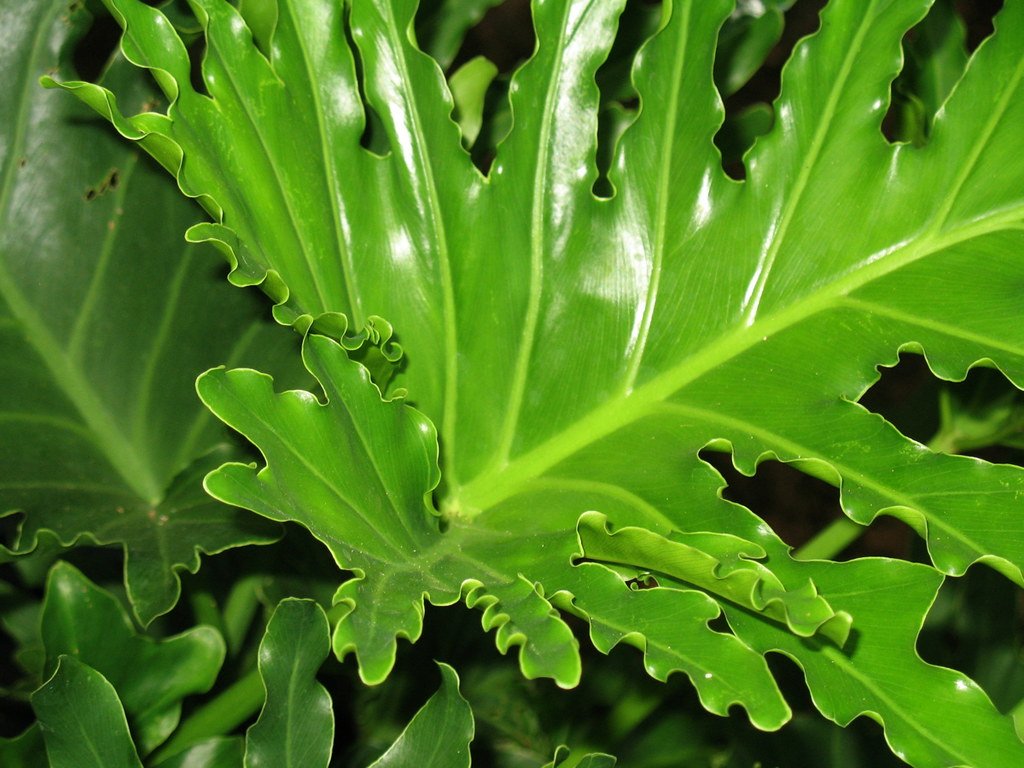
The Philodendron Green, a beloved classic among indoor plants, is well-known for its resilience, adaptability to low-light conditions, and ease of propagation. Here are some care tips for this wonderful, low-maintenance plant:
Light Requirements
Philodendrons are renowned for their ability to thrive in low-light environments. They can tolerate indirect or filtered light, making them perfect for spaces with limited natural sunlight. While they can do well in low light, providing them with brighter, indirect light can promote healthier growth and more vibrant foliage.
Watering
Allow the top inch or so of the soil to dry out before watering your Philodendron. These plants are forgiving when it comes to underwatering, but it’s important to maintain consistent moisture. Avoid overwatering, as it can lead to root rot. Ensure that the pot has proper drainage to prevent water accumulation at the bottom.
Humidity
Philodendrons are adaptable to average indoor humidity levels. However, they will appreciate occasional misting or placement near a humidifier, especially in dry indoor environments.
Temperature
Keep your Philodendron in a room with a comfortable temperature, typically between 65°F to 80°F (18°C to 27°C). Protect it from drafts or abrupt temperature changes.
Fertilizing
During the growing season (spring and summer), you can fertilize your Philodendron with a balanced, water-soluble fertilizer diluted to half strength every 4-6 weeks. Reduce or halt fertilization during the fall and winter when its growth slows down.
Potting Mix
Use a well-draining potting mix designed for houseplants. A mix suitable for aroids or tropical plants works well. Ensure that the pot has drainage holes to prevent waterlogged soil.
Propagation
Philodendrons are easily propagated through stem cuttings. Simply cut a section of the stem that includes a node (the small bump where leaves and roots develop), let it callus for a day or two, and then plant it in moist soil. Maintain consistent moisture until roots form.
Pruning
Prune your Philodendron as needed to control its size and shape, and to remove any leggy or dead growth. Regular pruning helps maintain its appearance and encourages bushier growth.
Philodendron Green’s trailing growth habit makes it an ideal choice for placing on elevated surfaces, allowing its graceful, cascading leaves to drape down. Its reputation for low maintenance and adaptability to low light make it a perfect addition to your indoor plant collection, whether you’re a beginner or an experienced plant enthusiast.
Hoya Heart
The Hoya Heart, also known as the Sweetheart Plant or Hoya Kerrii, is a charming and heartwarming succulent that makes an excellent gift for a friend or coworker. Here are some care tips for this adorable and low-maintenance plant:
Light Requirements
Hoya Hearts thrive in bright, indirect sunlight. Place your plant near a window with filtered or indirect light to ensure healthy growth. Avoid exposing it to direct sunlight, which can scorch the leaves.
Watering
One of the Hoya Heart’s remarkable features is its minimal watering requirements. Water it sparingly and allow the top inch or two of the soil to dry out before the next watering. During the growing season (spring and summer), water it slightly more frequently, but always be cautious not to overwater.
Temperature
Keep your Hoya Heart in a room with a consistent temperature range of 65°F to 80°F (18°C to 27°C). Avoid placing it near drafty areas or vents, which can subject it to temperature fluctuations.
Potting Mix and Container
Use a well-draining succulent or cactus potting mix. Ensure that the pot has drainage holes to prevent water from pooling at the bottom, which can lead to root rot. Hoya Hearts are often potted in small, heart-shaped containers, which add to their charm.
Humidity
Hoya Hearts are adaptable to typical indoor humidity levels. You won’t need to provide additional humidity or misting.
Fertilizing
Fertilize your Hoya Heart sparingly during the growing season, typically every 2-3 months, with a balanced, water-soluble fertilizer diluted to half strength.
Propagation
Hoya Hearts can be propagated through stem cuttings. To create a new plant, take a cutting with a node (where roots and leaves grow) and allow it to callus for a day or two. Then plant it in a pot with well-draining soil.
Pruning
Prune your Hoya Heart as needed to maintain its shape and size. You can also trim back any leggy or unhealthy growth.
The Hoya Heart’s heart-shaped leaves and easy-care nature make it an endearing and long-lasting gift. With minimal watering requirements, it can endure periods of neglect, making it a thoughtful and enduring token of friendship and appreciation. It’s sure to brighten up any desk or workspace and serve as a lasting reminder of your bond with your work bestie.
Neon Pothos
The Neon Pothos, also known as Epipremnum aureum ‘Neon,’ is a striking and eye-catching variety of Pothos. Its vibrant, neon-yellow-green leaves can indeed brighten up any space. Here are some care tips for this beautiful and low-maintenance plant:
Light Requirements
Neon Pothos thrives in bright, indirect light, but it can tolerate lower light conditions as well. To maintain its vibrant coloration and promote healthy growth, place it in a location with moderate to bright, indirect sunlight. However, avoid exposing it to direct sunlight, as this can scorch the leaves.
Watering
Like other Pothos varieties, Neon Pothos prefers to dry out slightly between waterings. Water the plant thoroughly when the top inch or so of the soil feels dry to the touch. Ensure that the pot has drainage holes to prevent water from stagnating in the soil, which can lead to root rot.
Humidity
Neon Pothos is adaptable to typical indoor humidity levels. It doesn’t require extra humidity, but misting the leaves occasionally can be beneficial, especially in dry indoor environments.
Temperature
Keep your Neon Pothos in a room with a consistent temperature between 65°F to 80°F (18°C to 27°C). Avoid exposing it to cold drafts or extreme temperature fluctuations.
Fertilizing
Fertilize your Neon Pothos during the growing season (spring and summer) with a balanced, water-soluble fertilizer diluted to half strength every 4-6 weeks. Reduce or halt fertilization during the fall and winter when the plant’s growth slows down.
Potting Mix
Use a well-draining potting mix suitable for houseplants. A mix formulated for aroids or tropical plants works well. Repot your Neon Pothos when it outgrows its current container or becomes root-bound, typically every couple of years.
Pruning
Prune your Neon Pothos as needed to control its size and shape, remove leggy growth, or encourage bushier growth. You can also propagate the cuttings to create new plants.
The Neon Pothos is an excellent choice for adding a burst of color to your home or office, and its low-maintenance qualities make it suitable for both beginner and experienced plant enthusiasts. With the right care, you can enjoy its vibrant foliage and watch it thrive even on dreary Mondays.
The impact of incorporating office plants into your workspace cannot be overstated. These desk plants have the remarkable ability to transform a mundane office into a vibrant and green workspace. With the myriad benefits they bring, from improved air quality to enhanced well-being and productivity, it’s clear that green office solutions are a wise investment.
As you consider your options for office plants and desk plants, remember that the key is to choose varieties that suit your environment and personal preferences. Whether you opt for low-maintenance succulents, air-purifying favorites like snake plants, or the vibrant aesthetics of flowering varieties, your green workspace is a reflection of your commitment to a healthier and more inspiring office.
We hope this guide has been a valuable resource in your quest to create a greener, more inviting office. By embracing office plants and incorporating them into your desk decor, you’re not only enhancing your surroundings but also fostering a more sustainable, green office culture. So, go ahead, bring the outdoors in, and watch as your green workspace flourishes, benefiting both you and your colleagues for years to come. Here’s to a more vibrant, productive, and eco-friendly future for your office!


